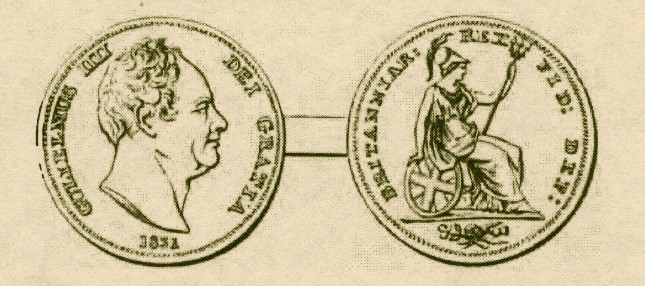

Penny
These occur of 1831, 1834 and 1837. Pennies of 1832, 1835 and 1836 are said to have been struck. It is almost
a certainty that those of 1832 and 1835 do not exist, and the existence of that of 1836 is very doubtful.
Bronze proof of 1831 occur, and with those of the halfpenny and farthing, form part of the Mint set.
Halfpenny
This occurs of the same dates as the penny, and there are proofs in bronze of 1831, as before mentioned.
Farthing
This occurs of 1831, 1834, 1835, 1836 and 1837, and there are proofs in bronze of those of 1831, and a rare bronze
proof of 1837.
No patterns for copper coins appear to have been struck during this reign, unless the following bronzed piece
may be considered one.
The use of the type of the reverse is the only circumstance which would induce the exclusion of this piece
from the class of medals, and it is possible it may have been designed as a pattern for a "commemorative"
penny, though the omission of the name of the reigning monarch is a suspicious feature.
The Copper, Tin, and Broze Coinage of England
H Montagu, F.S.A, , 1893
William IV
William IV, 1830-1837
The copper coins of this sovereign were not struck in any very great quantities, and are already somewhat scarce.
They consist of the penny, halfpenny, and farthing, for England; and the half-farthing and third of a farthing
for the Colonies as before. The half-farthing is of the date 1837 only, and is very rare.
1. O. GULIELMUS IIII DEI GRATIA. The king's head to the right, not laureate, neck bare. Under
his head, the date. On some of the pennies of 1831 but on none of other dates, W. W. (William
Wyon) incuse, is on the truncation of the king's shoulder.
R. BRITANNIAR: REX FID: DEF: Britannia, exactly as on the penny of George IV.
In the exergue, the rose, thistle and shamrock.

2. O. and R. As the penny, except that W. W. incuse occurs on the obverse of all the pieces.
3. O. and R. As the halfpenny.
4. O. VICTORIA. | MAGNAE. | SPES. ALTERA. | BRITANNIAE. | SOHO. 6. AUG. | 1830. In six lines, across the field.
R. From the reverse die of the penny of George III. of 1806.